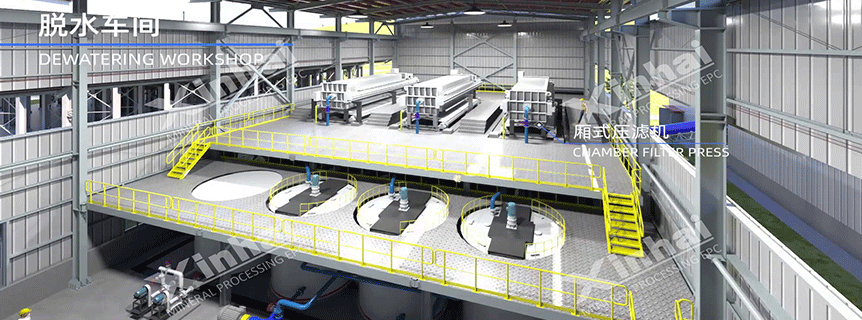What’s the Cost of Lithium Processing Plant?
 Sheena
Sheena
 Sep 26, 2024
Sep 26, 2024
 3056
3056
If you want to know more details about equipment, solutions, etc, please click the button below for free consultation, or leave your requirements!

lithium ore processing plant 3D picture
01What is a Lithium Processing Plant?
BackLithium, a critical energy metal, is widely used in the production of batteries for electric vehicles, smartphones, and energy storage systems. With the rapid global demand for renewable energy and electric transportation, the market demand for lithium has surged. A lithium processing plant extracts and refines lithium compounds from ore or brine, producing high-purity lithium compounds used in battery manufacturing. The production capacity of a lithium processing plant significantly impacts its efficiency and cost structure. This article focuses on the cost structure, technical challenges, and economic benefits of lithium processing plant.
02Cost Structure of a Lithium Processing Plant
BackBuilding and operating a lithium processing plant involves several costs, typically divided into capital expenditures and operating expenditures. Let's explore these in detail.
2.1 Capital Expenditures
CapEx refers to the initial investment required to construct a lithium processing plant, covering land, infrastructure, equipment, and construction costs.
Land and construction costs:
Land prices vary significantly depending on the plant location. Typically, lithium processing plants are located near the raw material source to reduce transportation costs. Construction costs primarily include factory buildings, storage facilities, and office space.
Equipment investment:
The core of a lithium processing plant is the processing and refining equipment. For a plant, equipment like crushers, grinders, dissolvers, precipitation systems, evaporators, crystallizers, and dryers form the major investment portion.
Infrastructure:
Besides core production equipment, the plant needs supporting infrastructure like power supply, water supply, wastewater treatment systems, and environmental protection facilities. Infrastructure costs vary based on local resources and regulatory requirements.
Engineering design and permits:
Prior to construction, engineering design, planning, and obtaining various government permits are necessary. These pre-construction costs are also part of CapEx.
The total capital expenditure for such a plant can range from tens of millions to several hundred million dollars, depending on the location, technology choices, and the complexity of the production process.
2.2 Operating Expenditures
OpEx refers to the ongoing expenses during plant operation, including raw materials, energy, labor, maintenance, and waste management.
Raw material costs:
The raw material for lithium processing mainly includes lithium-bearing ores (like spodumene) or brine. The price of lithium resources varies greatly depending on the source, with ore processing typically being more expensive than brine extraction.
Energy consumption:
Extracting and refining lithium requires significant energy, especially in processes involving high temperatures and pressures. Energy costs include electricity and fuel, with hydrometallurgical and high-temperature processes consuming the most. The adoption of energy-saving technologies can effectively reduce energy expenses.
Labor costs:
Hiring technical personnel, management, and operators is another operational expense. With the advancement of automation technology, many plants reduce labor reliance through digital control systems, but a skilled technical team is still required for equipment maintenance and operation.
Maintenance and repairs:
Regular maintenance of equipment and facilities is essential to ensure smooth plant operation. Maintenance costs include equipment inspections, part replacements, and emergency repairs.
Environmental protection and waste management:
Lithium processing generates wastewater, exhaust gases, and solid waste. Environmental regulations require plants to install advanced waste management systems to prevent pollution. Waste disposal costs include wastewater treatment and tailings management.
2.3 Cost Reduction Strategies
Cost control is critical for ensuring the profitability of a lithium processing plant. Several strategies can be implemented to reduce costs.
Optimizing supply chains:
Locating the plant near lithium mines or brine sources reduces transportation costs. Establishing long-term partnerships with raw material suppliers ensures stable pricing for raw materials.
Automation and digitalization:
Automation and smart plant management systems reduce labor costs and improve production efficiency. Real-time monitoring and data analysis help optimize production processes, reducing energy consumption and waste.
Economies of scale:
Expanding capacity or collaborating with other mining companies to share infrastructure, such as transportation networks and energy supply systems, helps lower per-unit costs.
03Economic Benefits and Market Outlook
BackWhile the capital and operating costs of a lithium processing plant are high, the market outlook is promising. The rapid growth of the global electric vehicle (EV) market has significantly boosted lithium demand, particularly for high-purity lithium compounds like battery-grade lithium carbonate and lithium hydroxide. Over the next few years, with more countries pushing for renewable energy policies, the demand for lithium batteries is expected to increase further.
For a lithium processing plant, although the initial investment is substantial, in the context of rising global lithium demand, the long-term economic benefits can be substantial.
04Conclusion
BackBuilding and operating a lithium processing plant requires significant capital investment and operational expenditure, covering land and infrastructure construction, equipment procurement, energy use, and environmental protection. However, through efficient cost control, supply chain optimization, and the adoption of advanced automation technologies, the plant can achieve high production efficiency and cost distribution, ultimately yielding significant economic returns.
With the rapid development of the EV and energy storage industries, global lithium demand is growing exponentially. The construction of lithium processing plants is not only a key investment area for the mining industry but also plays a crucial role in supporting the future transition to green energy.
 +86 183 3575 8886
+86 183 3575 8886 pinklaurabao@gmail.com
pinklaurabao@gmail.com




 Message
Message Chat Now
Chat Now

















